Agriculture Secretary Brooke Rollins said on Tuesday that the Trump administration will announce a 'bridge payment' for farmers next week that is designed to provide short-term relief while longer trade…
U.S. Corn, Soybean Conditions Fall Two Percentage Points Each
DTN Managing Editor Anthony Greder reported yesterday that, “U.S. corn condition fell for the first time in several weeks as intense heat baked much of the country last week, according to USDA NASS’ weekly Crop Progress report on Monday. Soybean conditions also declined for the second week in a row.”
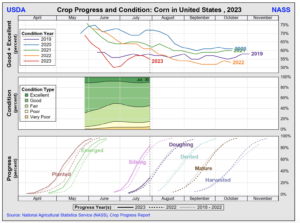
The DTN article stated that, “Nationally, corn was rated 55% good to excellent, down 2 percentage points from 57% the previous week and below 61% a year ago at this time. Texas, the Dakotas, Kansas and Minnesota showed the largest declines, noted DTN Lead Analyst Todd Hultman.”
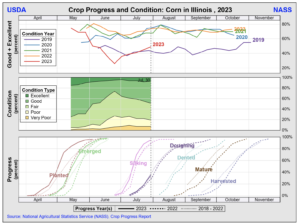
Greder explained that, “Soybeans were rated 52% good to excellent as of Sunday, down 2 percentage points from 54% last week and below 60% a year ago at this time. ‘Similar to corn, the largest declines were seen in Kansas, Minnesota and the Dakotas,’ Hultman said.”
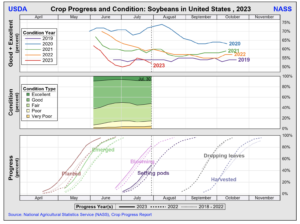
Dow Jones writer Yusuf Khan reported yesterday that, “Grain prices are starting to pull back from last week’s highs. Better growing weather in the U.S. helps to dampen supply fears despite worries over shipments from Ukraine. Heavy rains and cooler forecasts in the U.S. have helped to lower prices, with the expectation this weather pattern should continue into August.”
Aug. 6 - 10, Outlook. pic.twitter.com/x1yD2iXYbq
— FarmPolicy (@FarmPolicy) July 31, 2023
Reuters writer Christopher Walljasper reported yesterday that, “Chicago soybeans and corn fell on Monday, pressured by expectations of cooler, wetter weather across the U.S. Midwest in August.”
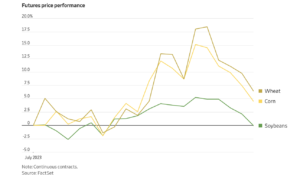
The Reuters article pointed out that, “Traders continue monitoring the war in Ukraine after Russia in July left Ukraine’s safe export shipping agreement and attacked Ukrainian grain export ports and infrastructure for Ukraine’s exports via the European Union along the Danube.”
More narrowly on this issue, Reuters News reported yesterday that, “Ukraine and Croatia have agreed on the possibility of using Croatian ports on the Danube and the Adriatic Sea for the export of Ukrainian grain, Foreign Minister Dmytro Kuleba said after talks with his Croatian counterpart on Monday.”
#Illinois topsoil moisture pic.twitter.com/qeLBgjxcXj
— FarmPolicy (@FarmPolicy) July 31, 2023
Elsewhere, Dow Jones writer Kirk Maltais reported yesterday that, “Wheat for September delivery fell 5.3% to $6.65 3/4 a bushel on the Chicago Board of Trade on Monday, in reaction to rain that arrived in U.S. growing areas over the weekend.”
30- Day Percent of Normal Precipitation pic.twitter.com/nHBU3uVQcp
— FarmPolicy (@FarmPolicy) July 31, 2023
Maltais also noted that, “Wet weather is the primary force behind lower grain futures, but slack export demand also factored into the equation today, said Arlan Suderman of StoneX in a note.”
The Dow Jones article indicated that, “Inspections of U.S. grain exports rose in the U.S. Agriculture Department’s latest report, although the levels remain relatively low.
“For the week ended July 27, the USDA said corn export inspections totaled 522,937 metric tons, soybean inspections came to 329,518 tons and wheat inspections were 581,278 tons.
“All three levels were higher than at this time last week, but total sales for the marketing year remain well behind the usual pace.”
And today, Reuters writer Naveen Thukral reported that, “Chicago corn and soybean futures rose on Tuesday after a U.S. government report showed that condition of both crops suffered amid hot and dry weather, with prices recovering from last session’s losses.”
“Wheat rose for the first time in five sessions as uncertainty over supplies from the Black Sea region underpinned prices.
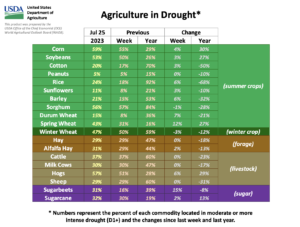
“‘There are forecasts of improved weather for the U.S. Midwest but there could be yield losses from heat the crop has already suffered in the last few weeks,’ said one Singapore-based trader.”
The Reuters article added that, “Brazilian farmers had harvested 55% of the area planted for their second corn crop in the center-south region by the end of last Thursday, consultancy AgRural said on Monday, up 8 percentage points from the previous week.”





